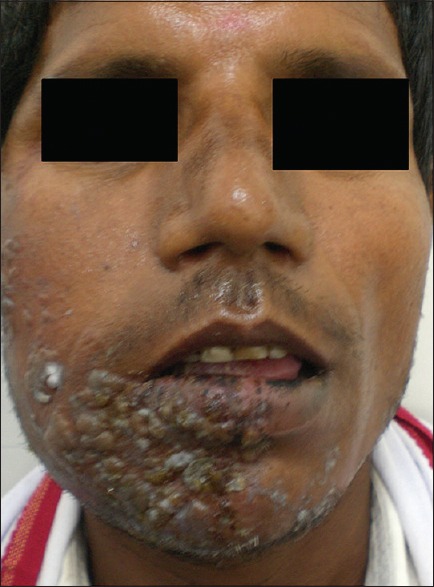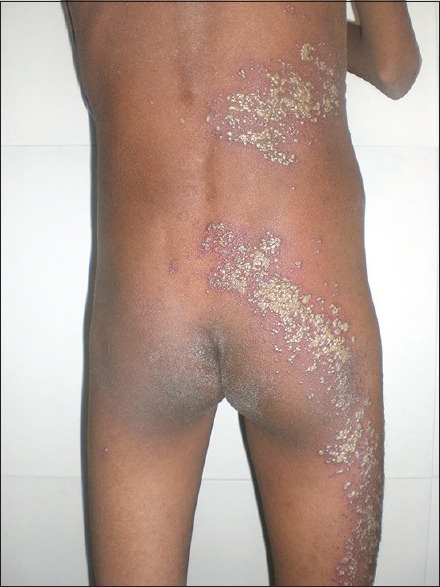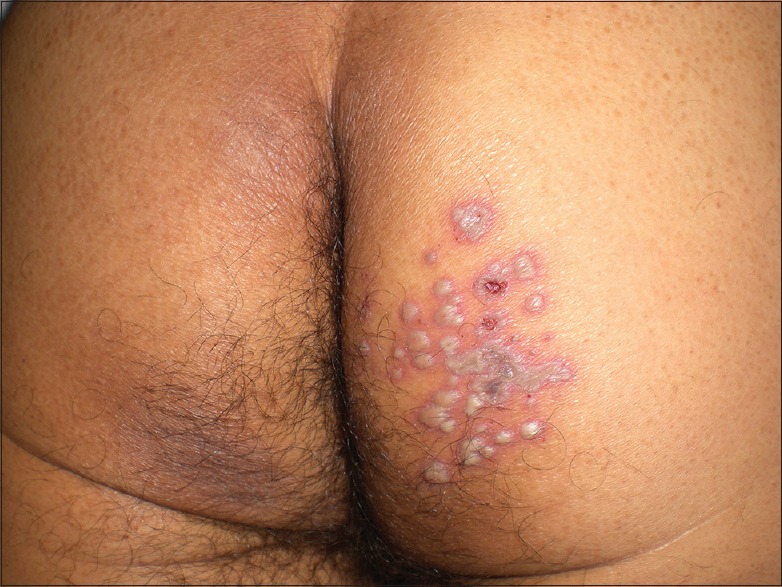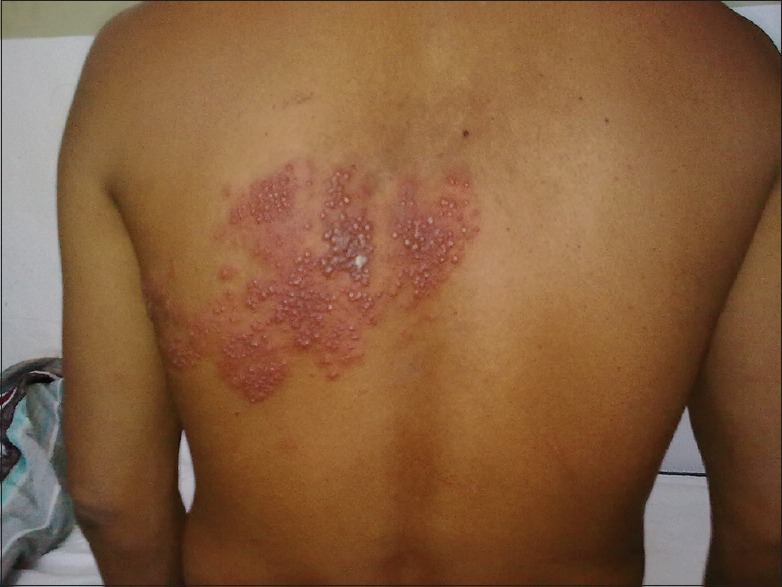Abstract
Background:
Herpes zoster usually presents with typically grouped vesicles on erythematous base involving single dermatome with self-limiting nature in immunocompetent individuals while it may present in extensive form involving multiple dermatomes involvement or disseminated form in immunocompromised, especially in human immunodeficiency virus (HIV).
Aims and Objectives:
The aim of this study was to study the prevalence of HIV in patients of herpes zoster, to compare the clinical presentation of herpes zoster in HIV-infected and noninfected patient.
Materials and Methods:
The study was carried out in the Department of Dermatology in a Teaching Institute of Gujarat, from June 2008 to May 2014 after ethical clearance. The study population included all the patients with a clinical diagnosis of herpes zoster. All the patients were investigated for HIV infection after written consent.
Results:
Out of total 688 patients of herpes zoster, 35 (5.1%) were HIV-positive, 26 (74.3%) were males and 9 (25.7%) were females. Among HIV-positive patients, 29 (82.85%) patients had localized dermatomal involvement, 4 (11.42%) patients had multiple dermatomal involvement, and only 2 (5.71%) had disseminated zoster while among HIV-negative, 636 (97.40%) had localized dermatomal involvement, 14 (2.14%) patients had multiple dermatomal involvement, and 3 (0.45%) had disseminated zoster. Cervical dermatome was most commonly involved dermatome in patients of HIV.
Conclusion:
Disseminated and multiple dermatomal involvement was more commonly involved among HIV-positive patients when compared to HIV-negative patients.
Key words: Herpes zoster, human immunodeficiency virus, immunosuppression
INTRODUCTION
Herpes zoster is characterized by unilateral radicular pain and grouped vesicular eruption that is generally limited to the dermatome innervated by a single spinal or cranial sensory ganglion, which is as a result of reactivation of varicella zoster virus that had persisted in latent form within sensory ganglion.[1] Triggering factors for reactivation include trauma, sunburn, exhaustion, injection, immunosuppression irradiation, or infection of human immunodeficiency virus (HIV). We did this study to know the difference in clinical presentation of herpes zoster in HIV-positive and HIV-negative patients.
Aims and objectives
To study the prevalence of HIV in patients of herpes zoster and to find out association between the two
To compare the clinical presentation of herpes zoster in HIV-infected and noninfected patients
To observe the change in clinical presentation of herpes zoster in HIV infected.
MATERIALS AND METHODS
The study was carried out in the Department of Dermatology in a Teaching Institute at a rural-based tertiary care center of Gujarat, from June 2008 to May 2014 after getting ethical approval from HREC Department of our institute. The study population included all the patients with a diagnosis of herpes zoster who were seen in outpatient clinic. In addition to obtaining a detailed questionnaire pertaining to sexual and drug history, a complete physical examination was done in all patients. The diagnosis of herpes zoster was made on clinical grounds and when required, confirmed by Tzanck smear. Sera of all cases was tested for antibody to HIV using a commercially available immunocomb test. Subsequently, seropositivity was confirmed by western blot assay. Fisher's exact test was performed and the “P” value reported.
RESULTS
Total 688 patients of herpes zoster were screened for HIV infection and 35 (5.1%) patients turned out to be HIV-positive out of which 26 (74.3%) were males and 9 (25.7%) were females, 653 (94.9%) patients were HIV negative among which 388 (59.4%) were males and 265 (40.6%) were females. Mean age of herpes zoster presentation for HIV-positive patients was 43.9 (standard deviation ± 14.8) years while for HIV-negative, it was 46 years (standard deviation ± 18.8 years). Out of HIV-positive patients, 33 (94.3%) were married compared to HIV-negative where 557 (85.3%) were married. History of chickenpox was seen in 10 (28.6%) and 146 (22.4%) patients, respectively, in HIV-positive and HIV-negative patients.
Multiple dermatomal involvement and disseminated herpes were more commonly observed among HIV-positive patients in 4 (11.4%) and 2 (5.7%), respectively, when compared to HIV-negative patients in 14 (2.1%) and 3 (0.5%), respectively. Localized dermatomal involvement was seen in 636 (97.4%) patients among HIV-negative patients when compared to 29 (82.9%) patients among HIV-positive patients [Figures 1–4]. These differences were statistically significant with Fisher P < 0.0001 [Table 1]. Cervical and Ophthalmic dermatomes were more commonly involved in HIV-positive patients in 10 (28.6%) and 9 (25.7%) patients, respectively, when compared to HIV-negative patients in 111 (17%) and 102 (15.6%), respectively. Thoracic dermatome was more commonly involved in HIV-negative patients 299 (45.8%) when compared to HIV-positive patients 8 (22.9%). This difference was statistically significant with fisher P = 0.004 (Fisher's exact test was performed to compare patients with cervical, thoracic, ophthalmic involvement) [Table 2].
Figure 1.

Herpes zoster involving mandibular division of trigeminal nerve with severe edema in a human immunodeficiency virus-negative male
Figure 4.

Multidermatomal involvement in a human immunodeficiency virus-positive male
Table 1.
Type of dermatomal involvement among human immunodeficiency virus-positive and human immunodeficiency virus-negative patients with herpes zoster

Table 2.
Site of involvement among human immunodeficiency virus-positive and human immunodeficiency virus-negative patients with herpes zoster

Figure 2.

Herpes zoster involving right S-2 (sacral) dermatome in a human immunodeficiency virus-negative male
Figure 3.

Herpes zoster involving left T4–T5 (thoracic) dermatome in a human immunodeficiency virus-positive male
DISCUSSION
The prevalence of HIV in general population of Gujarat is around 0.38%.[2] In our study, HIV prevalence among patients of herpes zoster was 5.1%. It ranged from 5.6% to 22.5% among various similar studies.[3,4,5,6] In a study at Lusaka, Zambia, it was found that 30% of the AIDS cases had developed herpes zoster.[7]
Herpes zoster occurs primarily in adults older than 50 years although it can occur at any age.[8] Mean age of presentation in Dubey et al. study among HIV-positive cases was 25.5 years while in our study, it is 43.9 years.[4] In Kar and Ramasastry study, all patients with herpes zoster gave history of occurrence of varicella during their childhood while in our study, history of varicella during childhood was only in about 22.67% patients.[3] This discrepancy in the results may be due to inability to recollect varicella occurrence in childhood.
Although uncommon in immunocompetent patients, zoster has high risk of dissemination up to 40%, in immunocompromised persons and in HIV infections.[9] It is defined as more than 20 vesicles outside the primary and immediately adjacent dermatomes and cutaneous dissemination is followed by visceral (lungs, liver, brain) involvement in 15% of high-risk patients. In our study, among HIV-positive, 4 (11.42%) patients had multiple dermatomal involvement, 2 (0.45%) had disseminated zoster while 29 (82.85%) patients had localized dermatomal involvement. Multiple dermatomal involvement and disseminated zoster in HIV-positive patients were statistically significant when compared to that of HIV-negative patients (P < 0.0001). In Dubey et al. study, among HIV-positive cases, 83.33% cases were having unidermatomal involvement and 16.6% case had disseminated zoster.[4] In Kar and Ramasastry study, one patient who was HIV seropositive had disseminated herpes zoster.[3] While in our study, 2 (5.7%) seropositive patients and 3 (0.5%) seronegative patients had disseminated zoster. Although disseminated zoster appears more commonly in HIV-positive patients, they also present as a typical zoster.
In our study, among HIV-positive patients, cervical, thoracic, and ophthalmic dermatomes affected in 10 (28.6%), 8 (22.9%), 9 (25.7%) patients. Cervical, ophthalmic dermatomes were more commonly involved in HIV-positive and thoracic dermatome was more commonly involved in HIV-negative patients and it was statistically significant (P = 0.004). In our study, most commonly involved dermatome in HIV-positive patients was cervical dermatome in contrast to various studies, where thoracic dermatome was more commonly involved among HIV-positive patients.[4,10,11]
Before the recognition of the current AIDS epidemic, herpes zoster had been most frequently seen in the elderly and among immunosuppressed patients.[9,12] Although death due to zoster is likely to be exceedingly rare in HIV-infected patients, zoster is an important cause of morbidity.[8]
The development of herpes zoster in otherwise asymptomatic individuals at high risk for HIV represents an early clinical sign that should alert the physician to consider the possibility of the impending development of an immune deficiency.[13] In India, where diagnostic facilities are often limited, herpes zoster may be used as a sentinel event for estimating the number of HIV-infected patients in a given population who will be requiring further screening tests for HIV.
CONCLUSION
As it is known that multidermatomal and disseminated involvement is more commonly seen in HIV-infected patients than in normal population. Many HIV-positive patients can present with typical presentation of zoster as seen in our study. Hence, every case of herpes zoster has to be screened for HIV infection to detect the disease earlier.
Declaration of patient consent
The authors certify that they have obtained all appropriate patient consent forms. In the form the patient(s) has/have given his/her/their consent for his/her/their images and other clinical information to be reported in the journal. The patients understand that their names and initials will not be published and due efforts will be made to conceal their identity, but anonymity cannot be guaranteed.
Financial support and sponsorship
Nil.
Conflicts of interest
There are no conflicts of interest.
REFERENCES
- 1.Straus SE, Schmader KE, Oxman MN. Varicella and herpes zoster. In: Freedberg IM, Eisen AZ, Wolff K, Austen KF, Goldsmith LA, Katz SI, editors. Fitzpatrick's Dermatology in General Medicine. 6th ed. Vol. 2. New York: McGraw Hill; 2003. pp. 2070–85. [Google Scholar]
- 2.National AIDS Control Organization, Ministry of Health and Family Welfare, Government of India: HIV Estimate during Surveillance in 2006 and Reported on 1st February, 2008.
- 3.Kar PK, Ramasastry CV. HIV prevalence in patients with herpes zoster. Indian J Dermatol Venereol Leprol. 2003;69:116–9. [PubMed] [Google Scholar]
- 4.Dubey AK, Jaisankar TJ, Thappa DM. Clinical and morphological characteristics of herpes zoster in South India. Indian J Dermatol. 2005;50:203–7. [Google Scholar]
- 5.Tunsuriyawong S, Puavilai S. Herpes zoster, clinical course and associated diseases: A 5-year retrospective study at Ramathibodi Hospital. J Med Assoc Thai. 2005;88:678–81. [PubMed] [Google Scholar]
- 6.Sharvadze L, Tsertsvadze T, Gochitashvili N, Stvilia K, Dolmazashvili E. HIV prevalence among high risk behavior group persons with herpes zoster infection. Georgian Med News. 2006;132:60–4. [PubMed] [Google Scholar]
- 7.Hira SK, Wadhawan D, Kamanga J, Kavindele D, Macuacua R, Patil PS, et al. Cutaneous manifestations of human immunodeficiency virus in Lusaka, Zambia. J Am Acad Dermatol. 1988;19:451–7. doi: 10.1016/s0190-9622(88)70197-8. [DOI] [PubMed] [Google Scholar]
- 8.McCrary ML, Severson J, Tyring SK. Varicella zoster virus. J Am Acad Dermatol. 1999;41:1–14. doi: 10.1016/s0190-9622(99)70398-1. [DOI] [PubMed] [Google Scholar]
- 9.Webre DM, Pelechia JA. Varicella pneumonia: Study of prevalence in adult men. JAMA. 1965;192:572–7. doi: 10.1001/jama.1965.03080190138035. [DOI] [PubMed] [Google Scholar]
- 10.Das AL, Sayal SK, Gupta CM, Chatterjee M. Herpes zoster in patients with HIV infection. Indian J Dermatol Venereol Leprol. 1997;63:101–4. [PubMed] [Google Scholar]
- 11.Sawhney CM, Sharma YK, Sayal SK. Mode of detection of HIV infection – A retrospective study of 612 cases. Med J Armed Forces India. 2005;61:220–3. doi: 10.1016/S0377-1237(05)80157-1. [DOI] [PMC free article] [PubMed] [Google Scholar]
- 12.Watson PN, Evans RJ. Postherpetic neuralgia. A review. Arch Neurol. 1986;43:836–40. doi: 10.1001/archneur.1986.00520080074027. [DOI] [PubMed] [Google Scholar]
- 13.Glesby MJ, Moore RD, Chaisson RE. Clinical spectrum of herpes zoster in adults infected with human immunodeficiency virus. Clin Infect Dis. 1995;21:370–5. doi: 10.1093/clinids/21.2.370. [DOI] [PubMed] [Google Scholar]


